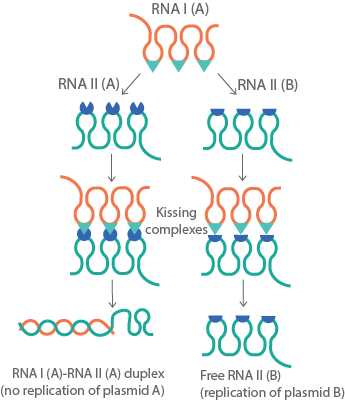Part:BBa_K2259076
SynORI inducible global copy number control device
This device is part of SynORI framework. It is used to induce a certain copy number of a plasmid.
See how this part fits into the whole SynORI framework by pressing here!
Sequence and Features
- 10COMPATIBLE WITH RFC[10]
- 12COMPATIBLE WITH RFC[12]
- 21COMPATIBLE WITH RFC[21]
- 23COMPATIBLE WITH RFC[23]
- 25COMPATIBLE WITH RFC[25]
- 1000COMPATIBLE WITH RFC[1000]
Introduction
Biology
Repressor of primer (ROP) is a small dimeric protein that participates in ColE1 plasmid family copy number control, by increasing affinity between two complementary RNAs - RNA I (Replication inhibitor) and RNA II (Replication activator) (Fig. 1). [1] By increasing affinity of the two RNA molecules Rop decreases the rate of of plasmid replication initiation events.

Rop dimer is a bundle of four tightly packed alpha helices that are held by hydrophobic interactions (Fig. 2).
Usage with SynORI (Framework for multi-plasmid systems)
About SynORI
SynORI is a framework for multi-plasmid systems created by Vilnius-Lithuania 2017 which enables quick and easy workflow with multiple plasmids, while also allowing to freely pick and modulate copy number for every unique plasmid group! Read more about [http://2017.igem.org/Team:Vilnius-Lithuania SynORI here]!
Regulative RNA II molecule in SynORI
RNA II gene is foundational and central biobrick of SynORI system, and by far the only one that is mandatory for framework to run. The two main functions of RNA II is as follows:
- Initiating plasmid replication
- Interacting with RNA I of specific plasmid group (See below)
RNA II and RNA I in the engineering of unique plasmid groups for multi-plasmid system
RNA II molecule interacts with inhibitory RNA I molecule with three secondary structure RNA stem loops. In order to create plasmid groups with independent copy number control, one group's RNA II molecule must interact only with the same group's RNA I molecule.
For example if there are two plasmid groups in a cell - A and B - RNA II of A group would only interact with RNA I A, and not RNA I B.
See the Design section or [http://2017.igem.org/Team:Vilnius-Lithuania Vilnius-Lithuania 2017 team wiki] for more insight about our synthetic origin of replication (SynORI).
Characterization of RNA II (Vilnius-Lithuania 2017)
RNA I inactivation in wild type replicon
References
- ↑ Castagnoli L, Scarpa M, Kokkinidis M, Banner DW, Tsernoglou D, Cesareni G. Genetic and structural analysis of the ColE1 Rop (Rom) protein. The EMBO Journal. 1989;8(2):621-629.
- ↑ Banner DW, Kokkinidis M, Tsernoglou D. Structure of the ColE1 Rop protein at 1.7 Å resolution. J Mol Biol. 1987 m.;196(3):657–75.
//collections/synori
| None |



